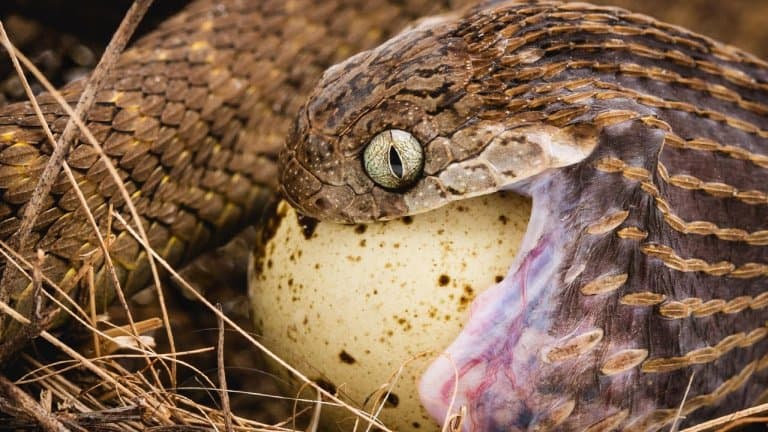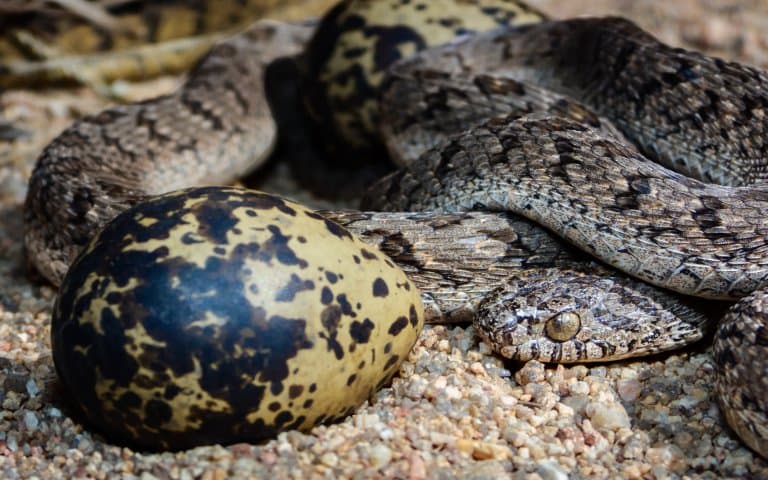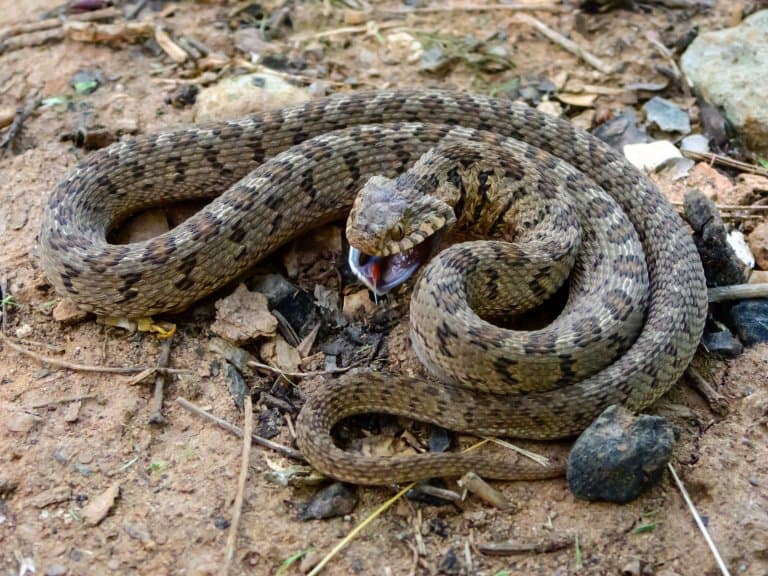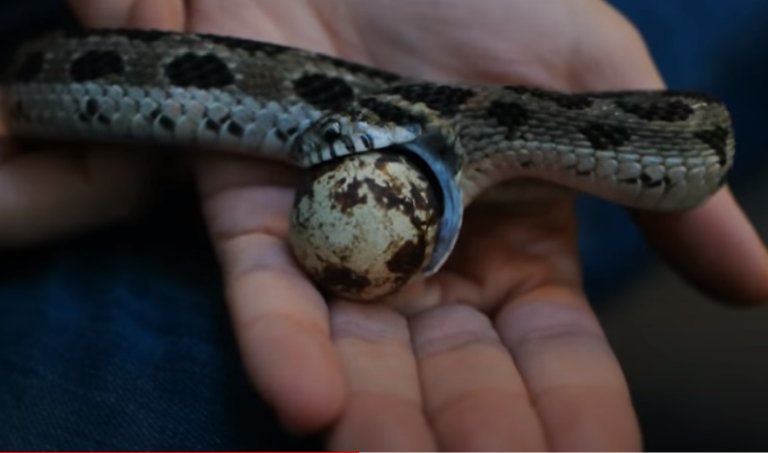Egg-Eating Snake Profile
Dasypeltis is the largest genus of egg eating snakes. They are found throughout sub-Saharan Africa as well as Saudi Arabia and Yemen.
There are 18 different species of egg-eating snakes, from two different genera. Dasypeltis, is by far the largest group of egg-eating snakes with all 17 species from Africa. The genus Elachistodon has just 1 species of rare egg-eating snake, the aptly named Indian egg-eating snake.
These snakes have all evolved to live exclusively on birds eggs and have adapted to live in locations with lots of birds to feed their egg-craving!

Egg-Eating Snake Facts Overview
| Habitat: | Found in a variety of habitats from semi-desert to savannah, forest and woodland |
| Location: | Most of sub-Saharan Africa, Saudi Arabia and Yemen |
| Lifespan: | Around 7 years in the wild |
| Size: | 30–100 cm (12–39.5 in) |
| Weight: | Average 500g |
| Color: | Brown, grey and green with patterns |
| Diet: | Birds eggs |
| Predators: | Raptors, other snakes, mongoose and honey badgers |
| Top Speed: | 10 kph (6 mph) |
| No. of Species: |
1 |
| Conservation Status: |
Least concern |
The 17 species in the Dasypeltis genus have a wide variety of color and patterns and range from 30–100 cm (12–39.5 inches) in length.
They are adaptable snakes, found in most habitats in Africa except arid desert and flooded plains. Dasypeltis are nocturnal snakes, spending the day in holes underground or in trees.
Dasypeltis and other similar species are relatively little studied, due to their shy nature and nocturnal behaviour. They prefer to avoid humans and are often only seen when birds are attempting to drive them away from their nests. As they are cold blooded reptiles, they hide in warm areas during the day, absorbing the latent heat from their surroundings. They leave their daytime homes in the early evening in search of eggs and may travel large distances to locate these.
During the night, they hunt either on the ground or in trees in search of bird eggs, which are the only food source they consume. At least unless scarce, some research has shown they will also eat eggs from lizards, other snakes, and snails in the wild as well. 1
Like other egg eating snake species, Dasypeltis have extremely flexible jaw muscles that allow them to swallow eggs that are much larger than their heads.
Although not often seen, some species are common across their range. Their numbers increase in areas where there is a diverse number of bird species and consequently nests. Here they play an important role in managing bird populations, especially those that nest throughout the year. 2
Interesting Egg-Eating Snake Facts
1. They can swallow eggs 3 times the size of their own head
Once they have chosen an egg, they will wrap their large jaws around the egg and using muscular contractions, move the egg into their stomach.
They lack teeth, which increases the capacity of the snakes mouth and are able to open their jaws to incredible proportions that allow them to swallow eggs.
The egg eater has bony protrusions which crush the egg and the entire contents of the egg are absorbed into the snakes body.
2. They have evolved to be almost completely toothless
Egg eaters have a jaw ridges rather than teeth, and this allows them to not only fit eggs in their mouth easier, but swallow them whole without breaking them.
3. They regurgitate the shell after
The shell is completely regurgitated after the contents have passed through the egg-eating snakes stomach.
This process ensures that the egg eating snake absorbs as many nutrients as possible from the egg and removes any waste. They may go for several days or weeks without eating again.
4. They smell with their tongues
Egg eating snakes flick out their tongues in the air and the chemicals it collects are passed to a special organ called the Jacobson’s organ.
This organ is able to process these smells and tells the snake whether an egg is ready to eat or not. They will smell a clutch of eggs and ignore those that are rotten or those that are too well developed and thus be more difficult to digest.

5. They can climb trees
Part of what makes these snakes so successful hunting is their ability to climb trees.
Birds that nest in colonies, such as some weavers species, are particularly attractive to egg eaters and many individuals may be found trying to locate eggs in the same tree. Dozens of egg eating snakes can sometimes be found in a single tree!

6. Their pattern and colouration is also used to confuse predators
The pattern on some species, such as the common egg eater, is quite similar to the venomous rhombic night adder and the African carpet viper and this may deter some predators from attacking. This imitation is known in the wild as ‘mimicry’. 3
7. Baby egg eating snakes feed on eggs of tiny species of birds
As they are completely independent the moment they are born, young egg eaters tend to hunt for eggs laid by some of the smallest bird species in the area.
8. They are completely harmless and pose no threat to humans
All species of Dasypeltis are completely non-venomous and rarely try to bite.
They avoid areas where people may frequently walk through. As with most egg eating snakes, they have greatly reduced teeth, so much so that they are almost toothless.

9. They make noise with their scales
As well as hissing and striking, this egg eater rubs its scales together to make a rasping sound as a defense mechanism when they are faced with a potential predator.
10. Female common egg eaters can lay up to 30 eggs
Though they typically lay fewer than 12 eggs, when prey is readily available, females can lay much large clutches of eggs.
11. Female egg eaters are bigger than males
The largest egg eating snakes are almost always female as they have to eat more to ensure they are able to produce healthy eggs.
12. They do not like to be picked up or disturbed
When handled, egg eating snakes in the genus Dasypeltis will hiss, wriggle wildly and even strike to get away from the person or animal disturbing it. As pets, they do still get picked up!

Common Egg-Eating Snake Fact-File Summary
Scientific Classification
| Kingdom: | Animalia |
| Phylum: | Chordata |
| Class: | Reptilia |
| Order: | Squamata |
| Family: | Colubridae |
| Genus: | Dasypeltis |
| Species Names: |
Dasypeltis abyssina Dasypeltis arabica (Arabian egg-eating snake) Dasypeltis atra (Montane egg-eating snake) Dasypeltis bazi Dasypeltis confusa (Confusing egg-eater) Dasypeltis congolensis Dasypeltis crucifera (Cross-marked egg-eating snake) Dasypeltis fasciata (Central African egg-eating snake) Dasypeltis gansi Dasypeltis inornata (Southern brown egg-eating snake) Dasypeltis latericia Dasypeltis medici (East African egg-eating snake) Dasypeltis medici lamuensis Dasypeltis medici medici Dasypeltis palmarum Dasypeltis parascabra Dasypeltis sahelensis Dasypeltis scabra (Common egg-eating snake or rhombic egg eater) Dasypeltis scabra loveridgei Dasypeltis scabra scabra Dasypeltis taylori |
Fact Sources & References
- D.G. Broadley (2011), “THE DIET OF DASYPELTIS“, Journal of the Herpetological Association of Rhodesia.
- Spawls, S., Howell, K.M., Drewes, R.C. (2006), “Reptiles and Amphibians of East Africa”, Bloomsbury Publishing.
- Crawl Gans (1960), “MIMICRY IN PROCRYPTICALLY COLORED SNAKES OF DASYPELTIS“, Wiley.
